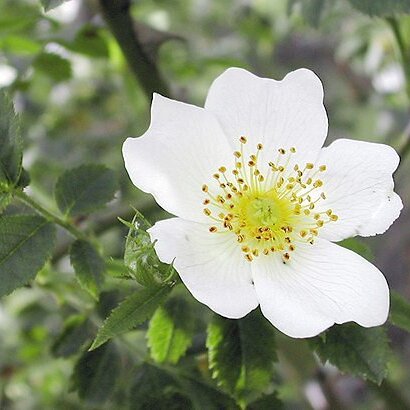Herbs (annual or perennial), shrubs, or trees. Stems simple or branched. Leaves persistent or deciduous, basal and/or cauline, usually alternate, rarely opposite, simple or compound (palmate or imparipinnate); stipules usually present, sometimes absent; petiole present or absent; blade thin to coriaceous, margins ± lobed or unlobed, usually toothed. Inflorescences terminal, sometimes axillary, panicles with terminal flower (that is, determinate) or reductions of this: 1-flowered, glomerules, fascicles, spikes, racemes, corymbs, umbels, or cymes. Flowers usually bisexual, rarely unisexual, perianth and androecium perigynous or epigynous; epicalyx bractlet sometimes present; hypanthium flat to hemispheric, or cylindric to funnelform or urceolate; sepals (0–)4 or 5(–10), distinct, free; petals (0–)4 or 5(–12, rarely more in double ornamentals), distinct, free; nectar disc sometimes absent; stamens 0–130(–220), distinct, free, anthers usually longitudinally dehiscent; torus well developed, inconspicuous, or absent; pistils 1–250(–450), distinct or ± connate, free or ± adnate to hypanthium, ovary superior or inferior (then 2–5-carpellate and-locular and ± connate with axile placentation), styles terminal, subterminal, lateral, or ± basal, sometimes basally connate, stigmas usually capitate; ovules 1 or 2(–5+), ?basal, marginal, or apical, collateral, superposed, biseriate, or clustered, integuments 2, crassinucellate, with or without obturator?. Fruits achenes aggregated or not, follicles aggregated or not, drupes aggregated or not, aggregated nutlets, pomes, aggregated drupelets, or capsules; ?sometimes involving accessory organs, for example, hypanthium, torus?. Seeds 1 or 2(–12+), not arillate.
Herbs, shrubs, scramblers or trees. Leaves simple or compound, alternate, stipulate. Flowers regular or irregular, hermaphrodite, monoecious, dioecious, or polygamous, perigynous or epigynous. Calyx campanulate or urceolate, free or adnate in part to the receptacle, sometimes gibbous and asymmetrical, the lobes 4–5, with or without an additional row of 4–5 alternating outer lobes (epicalyx). Receptacle flat, or convex and sometimes very accrescent, or concave, the mouth symmetrically or asymmetrically crateriform. Petals 5 or 0. Stamens 1 to many, sometimes biseriate, exserted or included, free or basally connate, regularly disposed or inserted on one side of the receptacle only; staminodes (if present) usually inserted on one side of the receptacle and there replacing the fertile stamens. Carpels 1 to many, free or fused to each other and to the receptacle, or fused but free of the receptacle. Styles terminal or basal, exserted or included. Ovules 1 or 2
Trees, shrubs, herbs or climbers, deciduous or evergreen; stems sometimes armed. Leaves mostly alternate, simple or compound, imparipinnate or palmate, margin often toothed; stipules present or absent. Inflorescence usually terminal, in panicles, racemes, corymbs, spikes, umbels, or flowers solitary. Flowers usually bisexual, actinomorphic; epicalyx of 4 or 5 sepal-like bracts often present; hypanthium present, sometimes fused to gynoecium. Sepals usually 4 or 5, free. Petals usually 4 or 5 (–10), free, caducous, or absent. Stamens mostly 5–many, free; anthers dehiscing by longitudinal slits. Gynoecium of 1 to many free or variously fused carpels. Ovaries superior or inferior, 1–5-locular; ovules usually 1 or 2 per carpel; styles simple, 1 per carpel. Fruits often aggregated, follicles, achenes, nutlets, drupes, druplets, pomes or capsules, sometimes included in the swollen hypanthium. Seeds with straight or bent embryo, usually without endosperm.
Calyx-tube short or elongated, free or adnate to the gynoecium; sometimes with an “epicalyx” of bracteoles; calyx-lobes usually 5, imbricate; disk usually present, lining the mouth of the calyx-tube, usually entire-margined
Fruits various, inferior to superior, naked or enclosed by the persistent calyx or calyx-tube, drupaceous, pomaceous, follicular, or composed of an indefinite number of achenes or drupelets, rarely capsular
Stamens usually numerous, usually in a complete ring at the margin of or above the disk; filaments usually free and filiform; anthers mostly small, dehiscing longitudinally
Petals inserted below the margin of the disk, as many as the calyx-lobes, imbricate or convolute, usually free, often deciduous, or absent
Carpels l–¥, free or connate and then usually ± adnate to the calyx-tube; styles terminal or basal; ovules often 2, rarely 1 or several
Leaves various, simple or compound, alternate or rarely opposite; stipules mostly present and paired, sometimes adnate to the petiole
Leaves alternate, rarely opposite or borne in groups of 2 or 3 at each node, simple or compound; stipules usually present and paired
Seeds erect or pendulous; endosperm absent or very rarely scantily present; cotyledons usually fleshy
Flowers actinomorphic or almost so, mostly bisexual, rarely dioecious or polygamo-dioecious
Carpels 1 or more, free or connate, superior or inferior; styles free or rarely connate
Stamens usually numerous; filaments free or connate; anthers small, 2-celled
Trees, shrubs, scramblers, brambles or herbs, rarely annuals in the FZ area
Fruit superior or inferior, drupaceous, pomaceous, follicular or achenial
Inflorescence corymbose, racemose or paniculate, or flowers solitary
Flowers actinomorphic or subzygomorphic, usually hermaphrodite
Calyx free or adnate to the ovary; lobes imbricate
Ovules 2 or more in each carpel, superposed
Petals present, rarely absent, imbricate
Seeds without endosperm
Trees, shrubs or herbs

